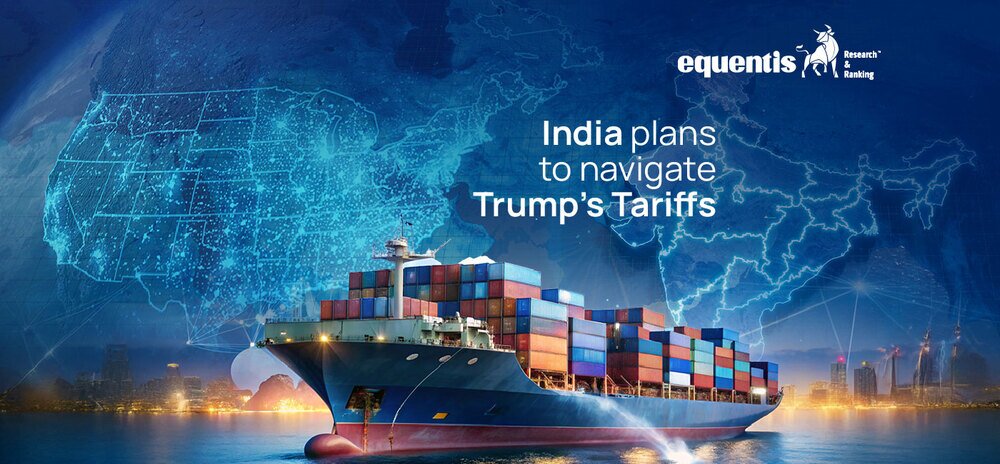As the United States, under President Donald Trump, initiates its “reciprocal tariffs” on April 2, 2025, India stands at a critical juncture, evaluating multifaceted strategies to mitigate potential economic repercussions. These tariffs, aimed at addressing perceived trade imbalances, have prompted India to assess various scenarios and formulate comprehensive responses to safeguard its economic interests.
Understanding the Implications of U.S. Tariffs
The U.S. tariffs are designed to impose additional duties on imports from several countries, including India, to encourage fair trade practices and reduce trade deficits. For India, a nation with significant export ties to the U.S., these tariffs could impact various sectors, particularly those heavily reliant on the American market.
In the fiscal year 2023-24, the U.S. accounted for approximately 18% of India’s total goods exports, underscoring the importance of this trading relationship (Economic Times).
India’s Strategic Response
In anticipation of the tariffs, India has adopted a measured approach, focusing on several key strategies:
- Bilateral Negotiations: India has engaged in extensive discussions with U.S. officials to address trade concerns and explore avenues for mutual concessions. These negotiations have led to finalizing the Terms of Reference for a Bilateral Trade Agreement (BTA), facilitated by the Prime Minister’s Office. The BTA aims to establish a framework for reducing trade barriers and enhancing economic cooperation between the two nations.
- Tariff Adjustments: To demonstrate goodwill and foster a conducive environment for trade talks, India has proposed lowering tariffs on select U.S. agricultural products and is considering reductions on liquefied natural gas (LNG) imports. These measures address specific U.S. concerns and pave the way for broader trade agreements (MoneyControl).
- Diversification of Trade Partnerships: Recognizing the risks of over-reliance on any single market, India actively seeks to diversify its trade relationships. Notably, China has expressed a willingness to import more Indian products, presenting an opportunity to offset potential losses from decreased U.S. market access. Strengthening ties with alternative trading partners can help mitigate the impact of U.S. tariffs (Reuters).
- Economic Impact Assessment and Policy Formulation: Indian authorities are conducting thorough assessments to understand the potential financial impact of the U.S. tariffs. This includes analyzing affected sectors, evaluating the implications for the Indian rupee, and formulating policies to support industries that may be adversely impacted. The rupee, which had seen a 3% gain against the U.S. dollar after a five-month losing streak, is projected to decline, potentially reaching 87.80 per dollar by March 2026 (Reuters).
Potential Scenarios and India’s Preparedness
Indian officials have outlined several scenarios to anticipate the possible outcomes of the U.S. tariffs:
- Product-Specific Tariffs: If the U.S. imposes tariffs targeting specific products, countries like China, Mexico, Canada, and the EU might be more affected, potentially making Indian exports more competitive in those segments. For instance, if steel and aluminum tariffs increase by 15%, India’s current steel export volume of 6.7 million metric tons to the U.S. (valued at $4.3 billion) could shift towards higher European and ASEAN demand.
- Sector-Specific Measures: Tariffs affecting entire sectors, such as pharmaceuticals or textiles, would increase costs globally, impacting all players, including India, by reducing profit margins and altering competitive dynamics. The Indian pharmaceutical sector, which exports $7 billion worth of generic drugs to the U.S. annually, could see a significant hit if tariffs increase by 10-12%.
- Country-Specific Tariffs: The direct impact could be severe if the U.S. implements tariffs specifically targeting India. India exported $78 billion worth of goods to the U.S. in 2024. A 5% across-the-board tariff would immediately add nearly $4 billion in additional costs for Indian exporters, forcing them to either absorb losses or increase prices, potentially reducing demand.
- Secondary Tariffs: Indirect effects, such as tariffs on other countries that disrupt global supply chains, could have cascading impacts on India’s economy. If China faces a 20% tariff on electronics, Indian semiconductor firms, which rely on Chinese inputs for manufacturing, could face increased costs and supply chain disruptions.
Collaborative Efforts and International Relations
India’s approach also involves active participation in international forums to advocate for fair trade practices and seek collective responses to protectionist measures. Some of the key collaborative efforts include:
- WTO Dispute Resolution: India, along with the EU, Canada, and Japan, has initiated discussions at the World Trade Organization (WTO) to challenge the legality of the U.S. tariffs under global trade rules. If the WTO rules against the U.S., it could open the door for retaliatory actions or exemptions.
- Regional Economic Partnerships: India is accelerating its engagement with trade blocs such as ASEAN, the European Union, and the BRICS nations. India’s recent Free Trade Agreement (FTA) negotiations with the UK and Australia have gained momentum, ensuring market diversification. Bilateral trade between India and ASEAN, which stood at $110 billion in 2023, is expected to increase by 20% as India redirects exports.
- Strengthening Domestic Manufacturing: To reduce reliance on imports and enhance self-sufficiency, India has intensified the implementation of the Production-Linked Incentive (PLI) schemes, offering $26 billion in incentives across sectors like electronics, automobiles, and renewable energy.
Conclusion
As the U.S. implements its reciprocal tariffs, India’s multifaceted strategy—encompassing diplomatic engagement, economic diversification, policy adjustments, and international collaboration—reflects a proactive and balanced approach to navigating the complexities of global trade dynamics. By carefully assessing potential impacts and exploring diverse avenues to mitigate risks, India seeks to protect its economic interests while fostering an environment conducive to sustainable growth and international cooperation.
Related Posts
Disclaimer Note: The securities quoted, if any, are for illustration only and are not recommendatory. This article is for education purposes only and shall not be considered as a recommendation or investment advice by Equentis – Research & Ranking. We will not be liable for any losses that may occur. Investments in the securities market are subject to market risks. Read all the related documents carefully before investing. Registration granted by SEBI, membership of BASL & the certification from NISM in no way guarantee the performance of the intermediary or provide any assurance of returns to investors.
How useful was this post?
Click on a star to rate it!
Average rating 0 / 5. Vote count: 0
No votes so far! Be the first to rate this post.
waitfor delay '0:0:5'--
I’m Archana R. Chettiar, an experienced content creator with
an affinity for writing on personal finance and other financial content. I
love to write on equity investing, retirement, managing money, and more.
 Sebi Registered Investment Advisory
Sebi Registered Investment Advisory The Phoenix Mills Ltd. (PDF)
The Phoenix Mills Ltd. (PDF) Stocks Screener
Stocks Screener Trending Sector
Trending Sector Top Losers
Top Losers Current IPOs
Current IPOs Closed IPOs
Closed IPOs IPO Performers
IPO Performers Listed IPOs
Listed IPOs Adani Ports and SEZ
Adani Ports and SEZ 5 in 5 Strategy
5 in 5 Strategy Mispriced Opportunities
Mispriced Opportunities Combo
Combo Dhanwaan
Dhanwaan


















